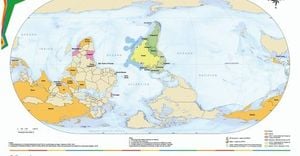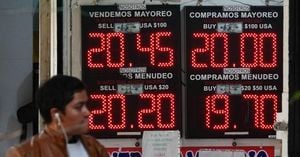Hurricane Milton has wreaked havoc across Florida, but one of the most vivid images from the storm’s destruction is the battered roof of Tropicana Field, home to the Tampa Bay Rays. Reports emerged on October 10, 2024, detailing how the powerful winds, which reached over 100 mph, tore through the stadium, causing significant damage.
Located in St. Petersburg, Tropicana Field was originally built to withstand winds up to 115 mph. This impressive feat of engineering, featuring the world’s largest cable-supported dome, was no match for Hurricane Milton when it swept through Florida late Wednesday night. The winds ripped through the Teflon-coated fiberglass roof, leaving massive holes and debris scattered across the baseball diamond.
Aerial footage and drone captures shared on social media depicted the aftermath, showcasing the devastation—a sight both surreal and haunting. Former NFL player Dave Moore, who shared his observations, noted, "It’s surreal to see the roof shredded like this. It had no chance against those winds of Hurricane Milton." Moore's sentiments echoed across the community as residents processed the damage.
St. Petersburg Fire Rescue reported no injuries related to the incident at the stadium, but the damage itself is still being assessed. Inside the stadium, it remains unclear what sort of devastation occurred, as the focus shifts to the broader impacts of the storm.
Before the hurricane approached, Tropicana Field was designated as a staging area for thousands of utility workers and National Guard members who were preparing for response efforts. Earlier this week, beds and cots were set up inside the stadium to house responders, ready to assist with any damages the storm would leave behind.
Just hours before Milton struck, Florida Governor Ron DeSantis confirmed the relocation of response resources to Jacksonville, stating, “Our priority is supporting our community and our staff.” This decision likely spared many lives, as the stadium had been filled with personnel preparing for recovery.
Hurricane Milton made its landfall near Sarasota, registering as a Category 3 storm before weakening to Category 1 as it moved inland. The storm’s effects were far-reaching, with reports indicating substantial damage across the region, including power outages affecting thousands of homes.
The initial reports of fatalities from Hurricane Milton have left the community grappling with its impact. At least 11 lives were lost due to the storm's relentless winds and torrential rains, illustrating the stark reality of these natural disasters.
Milton’s approach was initially anticipated to bring catastrophic storm surge and devastating flooding to the Tampa area. Fortunately, the landfall approximately 70 miles south of Tampa helped the city avoid the worst-case scenario officials had feared. DeSantis remarked, "Fortunately, Tampa avoided the worst-case scenario. We are grateful for all emergency services and responders who worked tirelessly."
Despite avoiding direct hits, the damage to Tropicana Field raises concerns for the future of the stadium. With the Rays recently concluding their competitive season, next steps for the upcoming 2025 season remain uncertain. The Rays have publicly expressed their priority lies with ensuring the safety of their community and staff, and there’s no rush to assess the damage fully until the storm’s impact is comprehensively understood.
Interestingly, the fate of Tropicana Field has been under discussion for years. Plans for a new $1.3 billion stadium are already underway, aiming to replace the aging structure by the 2028 season. While many fans welcomed this news, the current fate of the stadium casts doubt on whether it can serve as the home ground for the Rays moving forward.
Photos of Tropicana Field following Hurricane Milton depict not just the destruction but the resilience of the community as it begins the cleanup process. Looking back at the storm's impact, it’s evident how quickly nature can transform venues intended for joy and excitement—into sites of damage and devastation.
With continued forecasts indicating more severe weather patterns and storms on the horizon, the community remains on alert. Meanwhile, the Rays are committed to staying connected with their fans and the greater Tampa Bay area to navigate the next steps together.
Hurricane Milton’s legacy is now inseparably tied to Tropicana Field. The community's determination to recover from this disaster remains steadfast, as they begin to heal and rebuild, simultaneously keeping their eyes on the future and the hopeful return of baseball to the sun-drenched fields of Florida. All things considered, it’s just another chapter added to the rich history of storms and resilience seen throughout this vibrant state.



